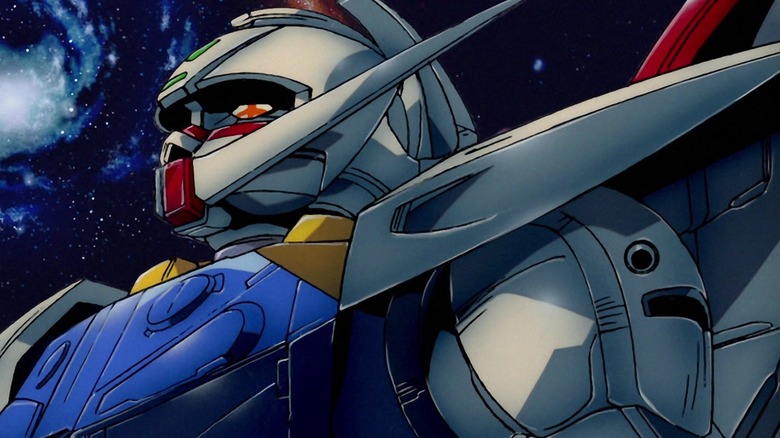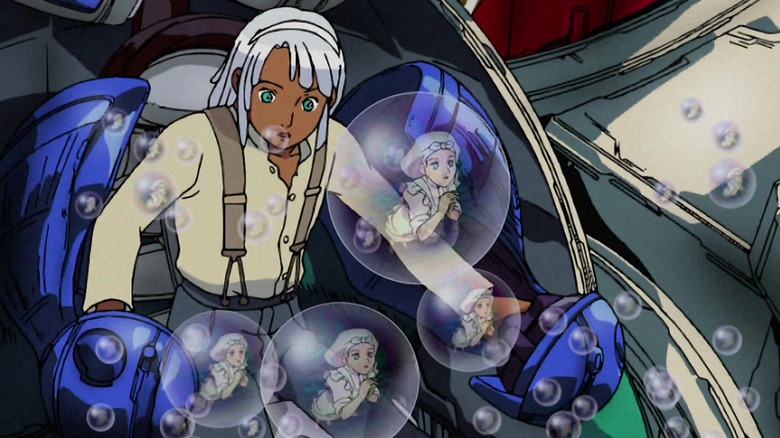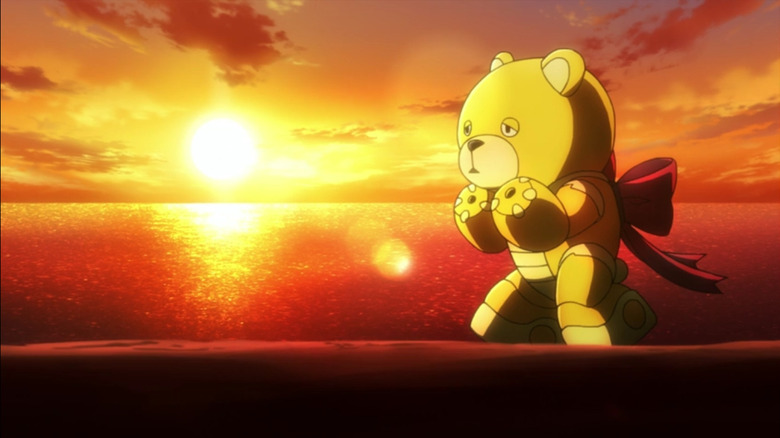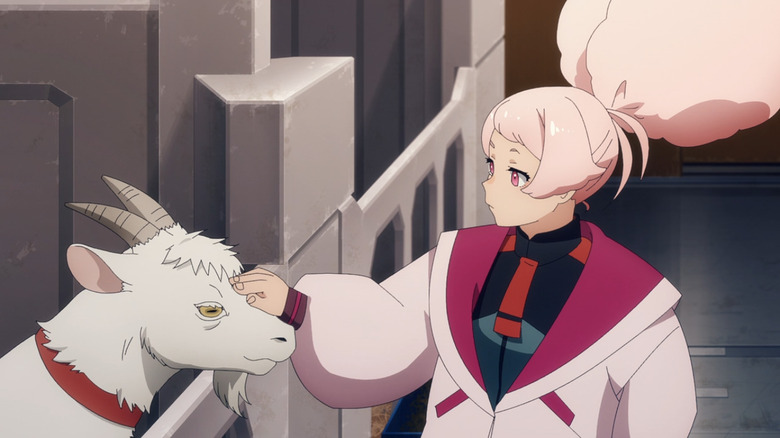Gundam Was Weird Long Before The Witch From Mercury
The newest season of the "Gundam" franchise, titled "The Witch From Mercury," has been an odd one. Rather than a tale of interstellar conflict, it's a high school story about teenagers who fight each other in school-sanctioned robot duels. It's the first "Gundam" series to star a female protagonist, and it borrows heavily from the surreal anime classic "Revolutionary Girl Utena." As always, there are fans out there who do not take kindly to that kind of thing — fans who believe that "Witch From Mercury" is a "Gundam" series in name only, made to appeal to casual viewers rather than the serious nerds who make up the franchise's real audience.
These embittered "Gundam" fans are wrong. "Witch From Mercury" is hardly the first weird "Gundam." In fact, "Gundam" has always been weird. This is a series whose characters have names like "Full Frontal" and "Biscuit Griffon." It is a series that features goofy animals and unexpected moments of humor in even the most tragic episodes. Of course, "Gundam" has always taken its weirdness seriously. Here are some notable examples of "Gundam" committing to the bit.
The east is burning red
"This hand glows with an awesome power," says the martial artist Domon Kasshu. "It is burning to defeat you!" So goes "Mobile Fighter G Gundam," the first and most infamous "alternate reality" "Gundam" series. Set during a martial arts competition that spans the solar system, "G Gundam" follows Domon as he searches for his evil brother Kyoji and the powerful Devil Gundam. In the process he fights some truly bizarre robots, including the Sailor Moon-inspired Nobel Gundam and the windmill-shaped Nether Gundam. Other designs, like the Tequila Gundam and Cobra Gundam, are gross ethnic stereotypes (as are their pilots.) The final battle ends with Domon and his girlfriend Rain defeating the planet-sized Devil Gundam with the power of love.
Plenty of folks love "G Gundam" for its absurdity, but just as many "Gundam" fans dismiss it for that reason. Of course, "G Gundam" has more to offer than simple absurdity. Director Yasuhiro Imagawa was an experienced "Gundam" director in the midst of developing the classic OVA "Giant Robo" when he took the job. His take on "Gundam" is a wuxia story that borrows from King Hu and Jin Yong as often as other anime and manga. It's a show that loves Hong Kong cinema so much that a key theme song has Cantonese lyrics, and a villain's name references Chow Yun Fat. My favorite character is Master Asia, Domon's martial arts teacher who betrays him in order to save the world. Domon's final duel with his master is an all-time "Gundam" highlight that could only work in the weird world of "G Gundam."
Moon's cocoon
One of the most significant creative voices involved in "Gundam" was Yoshiyuki Tomino, who directed the original "Mobile Suit Gundam" and its popular sequel "Zeta Gundam." Yet he took a break from anime after the excruciating "Victory Gundam," citing a deep depression. He returned to the series six years later with "Turn A Gundam." But this was not the "Gundam" that fans were familiar with. "Turn A" is set in a world of steam technology. Rather than being drafted into a war, the hero Loran must negotiate a ceasefire between Earth's inhabitants and the technologically advanced Moonrace. The robots are designed by American designer Syd Mead, and the titular Turn A Gundam has a mustache. Not to mention the crossdressing, cow lifting, mistaken identities and a scene where the Turn A becomes a washing machine.
Tomino was once nicknamed "Kill 'em All Tomino" for his murderous ways. He mellowed out in his years away from the industry, but never lost his ambition to expand the range of what anime could do. "Turn A" utilized fashion as a means of world and character development, courtesy of the designer Akiman. Court intrigue took on importance alongside politics and military battles. Not to mention that the female cast in "Turn A" might be the best in the history of the franchise. Tomino's daughters, who exposed him to dance and the famous Takarazuka Revue, may be partly responsible. Even so, "Turn A" has that ineffable "Gundam" feel. Its storyboarding and pacing are rough around the edges, much like Tomino's earlier work. The characters spout non-sequiturs like "UNIVERSE!" While "Turn A Gundam" was seen as an outlier when it aired, it has since claimed its place in history as a definitive "Gundam" series–and perhaps the best.
Six times the passion of ordinary flamenco
Yoshiyuki Tomino and his crew made the original "Mobile Suit Gundam" to prove that giant robot anime could do more than just sell toys. As it happened, though, one of the best "Gundam" anime of recent years is an explicit toy commercial. "Gundam Build Fighters" is a children's anime about a boy named Sei who loves building model "Gundam" toys, called "gunpla." When he meets another boy named Reiji, the two join forces and enter the Gunpla Battle World Championship. Just like the world of "Yu Gi Oh" revolves around cards, gunpla is a matter of life and death in "Build Fighters."The owners of these toys can even "pilot" them in virtual duels. "Mobile Suit Gundam" depicted war as a terrible thing, but the battles of "Build Fighters" are purely joyful.
You'd expect that "Gundam" fans would reject "Build Fighters" as a desecration of the show's original ethos. Instead, they welcomed it with open arms. It helped that "Build Fighters" had the best animated robot fights the franchise had seen in ages. But the show's secret weapon was its countless references to the broader "Gundam" series. Sei and Reiji are trained by "Mobile Suit Gundam" antagonist Ramba Ral. A hot spring hides an encounter with the Asparas III from "08th MS Team." One episode in particular near the end features non-stop cameos by "Gundam" characters past and present. It even writes an alternate happy ending to the infamously bleak "War in the Pocket." Just a few years later, the director, writer and composer for "Build Fighters" were recruited to lead "My Hero Academia."
It's all Gundam
The larger "Gundam" franchise is full of contradictions. It's capable of heartrending stories about war and loss, but also features cool and outrageous robot fights. Yoshiyuki Tomino raged against the influence of toy companies on the original "Mobile Suit Gundam," and yet "Gundam" fans unabashedly revere those toys. The themes of "Gundam" speak directly to our present, and yet the scarcity of mechanical animators has made 2D "Gundam" anime a difficult proposition. Early "Gundam" series treated their female characters poorly, and yet the original "Mobile Suit Gundam" survived its early cancellation due to dedicated female fans.
"The Witch From Mercury" itself embodies many of those contradictions. It's a charming school story that hides a traditional "Gundam" narrative behind the scenes. Despite breaking from tradition in a number of ways, it stars characters with names like "Chuatury Panlunch" as well as a goat that makes funny expressions. The series condemns the worst excesses of corporate capitalism, and yet its production is so strapped for time that the upcoming seventh episode will be a recap. The barely suppressed tension between art and product sings through "Witch From Mercury," just as it did through the original "Mobile Suit Gundam." So long as "Gundam" never settles for just being ordinary, I reckon it will survive.




